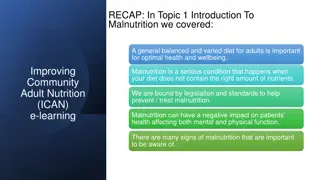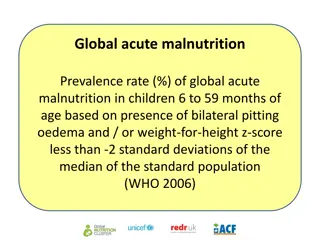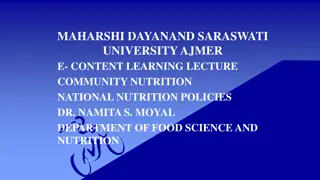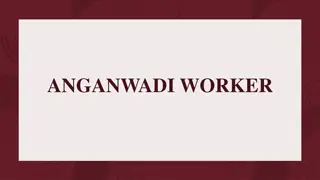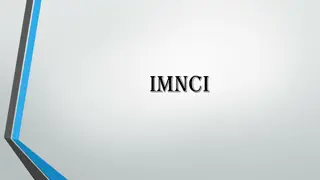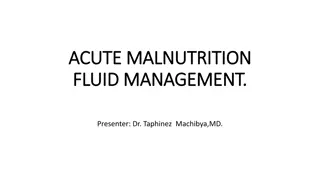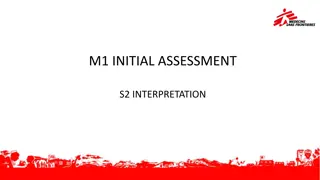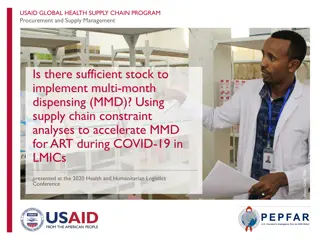
Holistic Approach to Addressing Child Malnutrition in LMICs
Tackling the burden of malnutrition arising from child poverty in Low- and Middle-Income Countries requires a comprehensive response. Explore the causes of poverty and its relationship with malnutrition, the impact of inequality on malnutrition prevalence, and the vulnerability of children to malnutrition. Understand the significance of addressing malnutrition in combating child poverty through effective policy actions and initiatives.
Download Presentation

Please find below an Image/Link to download the presentation.
The content on the website is provided AS IS for your information and personal use only. It may not be sold, licensed, or shared on other websites without obtaining consent from the author. If you encounter any issues during the download, it is possible that the publisher has removed the file from their server.
You are allowed to download the files provided on this website for personal or commercial use, subject to the condition that they are used lawfully. All files are the property of their respective owners.
The content on the website is provided AS IS for your information and personal use only. It may not be sold, licensed, or shared on other websites without obtaining consent from the author.
E N D
Presentation Transcript
THE STANDARD DEVELOPMENT ROUTE Absorb surplus agriculture labor in low-skilled manufacturing assembly. Focus on exports for scale. Move up the value chain. Move labor to services and manufacturing related services. Start with agricultural reforms. Enhance productivity and surpluses.
WHY DID CHINA SUCCEED AT MANUFACTURING AND INDIA NOT? Emphasized early education and skilled workforce Suppressing market and democratic forces Government decentralization and competitive cronyism
SECTORAL EMPLOYMENT SHARES CONTD. Share of employment in manufacturing stagnant since 1980s. Services employment expanded until 2019. Is this pre-mature de-industrialization or a reflection of India s comparative advantage? Why is agricultural employment share increasing?
Labor force participation low, female participation alarmingly so. Yet unemployment numbers high, disguised unemployment even higher. Enormous numbers applying for government jobs. Yet, capital intensity of manufacturing increasing. Demographic dividend is in danger of being frittered away. INDIA HAS A PROBLEM: JOBS
WHICH WAY SHOULD INDIA GO NOW? Turn back clock to hop on to the low skilled manufacturing bus? Or figure out what makes sense for the future? Determines how India uses its resources.
1. OLD PATH IS NARROWING Globalization backlash: nearshoring and on-shoring Room for another China? No longer competing with the US in assembly and low-skilled manufacturing: competing with Indonesia, Mexico, Vietnam, China, and robots
2. NEW PATHWAYS: THE SMILE CURVE Value added APPLE Allied Services R&D NVIDIA Design Marketing FOXCONN Logistics purchase The older story Logistics TSMC Production Value chain activies Pre-production intangibles Post-production intangibles Production tangibles
3. THE GROWING PROMISE OF SERVICES A haircut: fixed in time and space Modern services are not, especially after the pandemic. Differentiated by Target customer: Foreign Domestic Direct services Links to manufacturing: Embedded in manufacturing GCCs Enabling manufacturing
DOES INDIA HAVE TO CHOOSE ? India does not do industrial policy well Therefore, not manufacturing or services but Upgrading human capital vs focusing on physical capital. Broad upskilling so workers are fit for decent jobs Higher end also Fostering innovation and creativity to capture high value added
HOW CAN GOVERNMENT MEET CHALLENGES? Decentralize more Freebies vs public goods Spend budget wisely Chips vs chip engineers
WHAT ABOUT INDIAN DEMOCRACY: BUG OR FEATURE? Knowing when off track Protest to get good service Creativity and innovation Trust
WILL A NEW EMPHASIS CREATE ENOUGH JOBS? Compete globally for higher end jobs with more capable human capital. Last mile remedial education, corporate teaching, apprenticeships Expand childcare, education, healthcare (some short, some longer term) These will themselves entail job creation For every high end job, four others are created. Driver, cook, security guard, and their arm s length equivalents
ENOUGH JOBSCONTD? Labor intensive domestic services using moderate skills Plumbing, carpentry, retail, hospitality Local government with upgraded public services Construction A global market for handicrafts. Enable manufacturing by fixing India s deficiencies, not just through subsidies. Rural and agri-based industry,
INDIA/US : OPPORTUNITIES India growing and enormous market Diaspora links the two countries Positive Indian public attitude towards US China China+1 Quad Services Shared democratic values
INDIA/US : CHALLENGES Nationalism + Protectionism Creeping authoritarianism
THE INDIA WAY Much to do. Chart an Indian way, building on India s strengths Model for Africa, South Asia, and South America India will succeed if it emphasizes the ideas of the future, taking inspiration from, rather than living in, the past




